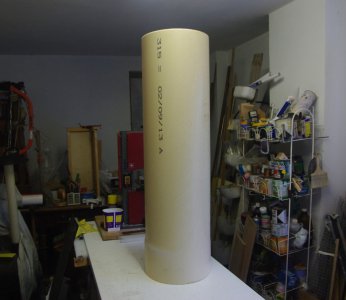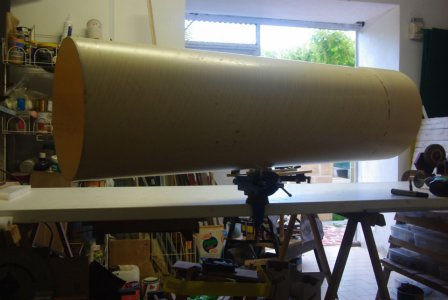- Joined
- Dec 17, 2012
- Messages
- 745
I keep my anvil in the garden, because I don't have space enough in the "goat room" I use as shop.
Since during the summer we rent the lower half of our home, I want to avoid the kids of tourists (the people causing the need for absurd warning signs on tools… define them as you want) will hit the anvil horns with their heads, or the parents will break their back trying to lift it («Hey, look at this!»).
So I bought a 315 mm PVC pipe to make a sort of "lid", surrounding the whole anvil, which I'll screw to the base.
Now the problem is: how to cut straight the PVC without the machine used by plumbers?
None of the plumbers in the surround has a machine large enough, and all of them suggested to use a hacksaw and some sand paper to reduce the "jagginess" of the cut, but I know I'll get a very rough result.
I have to reduce the length of the pipe and to make two cuts along it, so it can slide around the anvil feet.
My idea for the shortening cut is to place the pipe vertical on the table, clamp a hand drill with a slitting saw on the edge and turn the pipe until it's cut.
But for the longitudinal cuts I've no idea how to make a jig: a 315 mm pipe is not actually easy to be placed into a V block…
I'm thinking to a piece of thin iron wire with a couple of lump hammers hanging from it to keep it straight, and a welding torch to make the wire hot enough to cut the PVC. Do you think this could be a solution?
I can't make tests because I bought all the 315 mm pipe available in the valley (1 metre!), so the first attempt must be the good one.
Since during the summer we rent the lower half of our home, I want to avoid the kids of tourists (the people causing the need for absurd warning signs on tools… define them as you want) will hit the anvil horns with their heads, or the parents will break their back trying to lift it («Hey, look at this!»).
So I bought a 315 mm PVC pipe to make a sort of "lid", surrounding the whole anvil, which I'll screw to the base.
Now the problem is: how to cut straight the PVC without the machine used by plumbers?
None of the plumbers in the surround has a machine large enough, and all of them suggested to use a hacksaw and some sand paper to reduce the "jagginess" of the cut, but I know I'll get a very rough result.
I have to reduce the length of the pipe and to make two cuts along it, so it can slide around the anvil feet.
My idea for the shortening cut is to place the pipe vertical on the table, clamp a hand drill with a slitting saw on the edge and turn the pipe until it's cut.
But for the longitudinal cuts I've no idea how to make a jig: a 315 mm pipe is not actually easy to be placed into a V block…
I'm thinking to a piece of thin iron wire with a couple of lump hammers hanging from it to keep it straight, and a welding torch to make the wire hot enough to cut the PVC. Do you think this could be a solution?
I can't make tests because I bought all the 315 mm pipe available in the valley (1 metre!), so the first attempt must be the good one.




